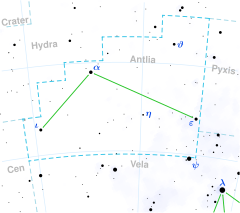Binary star system in the constellation Antlia
Theta Antliae (θ Ant, θ Antliae) is the Bayer designation for a binary star in the southern constellation of Antlia . The pair have a combined apparent visual magnitude of +4.78; the brighter component is magnitude +5.30 while the secondary is +6.18. Based upon parallax measurements, it is located at a distance of around 430 light-years (130 parsecs ) from Earth .
The primary component of this system, θ Antliae A, has a stellar classification of A8 Vm, indicating that it is an A-type main sequence star with enhanced metallic lines in its spectrum . The companion, θ Antliae B, is a giant star with a classification of G7 III. The pair have an orbital period of 18.3 years, a significant eccentricity of 0.445, and they have an angular separation of 0.1 arcseconds .
References
^ van Leeuwen, F. (November 2007), "Validation of the new Hipparcos reduction", Astronomy and Astrophysics , 474 (2): 653–664, arXiv :0708.1752 , Bibcode :2007A&A...474..653V , doi :10.1051/0004-6361:20078357 , S2CID 18759600 .
^ Johnson, H. L.; et al. (1966), "UBVRIJKL photometry of the bright stars", Communications of the Lunar and Planetary Laboratory , 4 (99): 99, Bibcode :1966CoLPL...4...99J .
^ Ginestet, N.; Carquillat, J. M. (December 2002), "Spectral Classification of the Hot Components of a Large Sample of Stars with Composite Spectra, and Implication for the Absolute Magnitudes of the Cool Supergiant Components", The Astrophysical Journal Supplement Series , 143 (2): 513–537, Bibcode :2002ApJS..143..513G , doi :10.1086/342942 .
Wilson, Ralph Elmer (1953), "General catalogue of stellar radial velocities", Washington , Carnegie Institution of Washington, Bibcode :1953GCRV..C......0W .
Brown, A. G. A. ; et al. (Gaia collaboration) (August 2018). "Gaia Data Release 2: Summary of the contents and survey properties" . Astronomy & Astrophysics 616 . A1. arXiv :1804.09365 . Bibcode :2018A&A...616A...1G . doi :10.1051/0004-6361/201833051 .Gaia DR2 record for this source at VizieR .
^ Heintz, W. D. (March 1982), "Orbits of 16 visual binaries", Astronomy and Astrophysics Supplement Series , 47 : 569–573, Bibcode :1982A&AS...47..569H .
Docobo, J. A.; Andrade, M. (2012). "Dynamical and physical properties of 22 binaries discovered by W. S. Finsen" . Monthly Notices of the Royal Astronomical Society . 428 (1): 321–339. Bibcode :2013MNRAS.428..321D . doi :10.1093/mnras/sts045 .
"tet Ant" . SIMBAD Centre de données astronomiques de Strasbourg . Retrieved 2012-06-28.{{cite web }}: CS1 maint: postscript (link )
Eggleton, P. P.; Tokovinin, A. A. (September 2008), "A catalogue of multiplicity among bright stellar systems", Monthly Notices of the Royal Astronomical Society 389 (2): 869–879, arXiv :0806.2878 , Bibcode :2008MNRAS.389..869E , doi :10.1111/j.1365-2966.2008.13596.x , S2CID 14878976 .
Categories :
Theta Antliae
Add topic
Text is available under the Creative Commons Attribution-ShareAlike License. Additional terms may apply.
**DISCLAIMER** We are not affiliated with Wikipedia, and Cloudflare.
The information presented on this site is for general informational purposes only and does not constitute medical advice.
You should always have a personal consultation with a healthcare professional before making changes to your diet, medication, or exercise routine.
AI helps with the correspondence in our chat.
We participate in an affiliate program. If you buy something through a link, we may earn a commission 💕
↑
